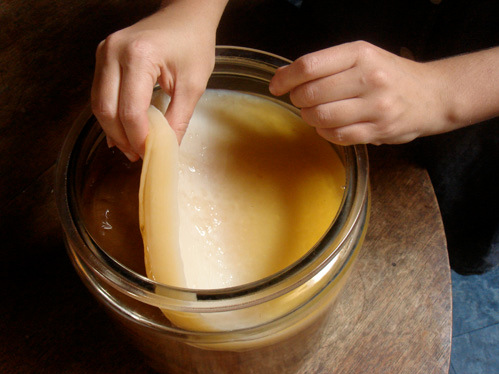
Projects from Make: Magazine
Kombucha Madness

- Time Required: 1–3 Hours
- Difficulty: Easy
- Print this Project


You can buy kombucha culture on the web, but it’s probably easier to get it from a friend or someone in your neighborhood (try craigslist.org or bulletin boards at your local health food store). I even saw some for sale at a flea market in Russia (pictured). The starter replicates itself in each batch, so one is enough for your lifetime. Soon you’ll have a culture for everyone you know!
Make 3 quarts to 1 gallon of tea (if you have loose tea you can make a tea bag out of a piece of an old sheet and some string) and let cool to room temperature. Remove tea bags and add sugar. Don’t worry if it seems too sweet — the culture feeds on sugar and caffeine, so the final drink will not be as sweet as the original.
If your culture came with some liquid, add the starter liquid to the tea. Pour the sweet tea into your jar and add the culture. If it floats on top, it will grow another layer, which can be peeled off and used for another batch when the kombucha is ready. If it settles to the bottom, that’s fine — a new culture will form on top of the tea. The starter will grow to the diameter of your jar, so make sure the mouth is wide enough to remove it easily when you are done.
Cover your jar with a clean towel and seal around the rim with a rubber band. Store in a spot out of direct sunlight for 7–14 days. The longer you leave your tea, the more sour it will become. Start tasting it after 5 or 6 days, and decant into clean plastic or glass soda bottles when you like the taste.
To give it some bubble, tightly cap bottles and store in a warm place for another day or so until the plastic bottle hardens from pressure. Be aware that as the kombucha continues to ferment, the pressure inside the bottle is growing and can cause it to explode if left too long (this is more of a concern with glass bottles). If you’re worried, leave the cap a little loose, but this will prevent the tea from fizzing properly.
Always set aside 10% of the liquid to help start future batches. Then you can start all over again! If you want a steady flow of “the tea of immortality,” then it probably makes sense to stagger your batches. Most experts warn against drinking too much of the stuff; it is a detoxifier, so you don’t want to stress out your body.
NOTE: As with all foods, be careful when preparing and storing kombucha. While I personally have never heard of anyone getting sick, it is theoretically possible, so make sure everything is clean while preparing; if you see mold, toss the entire batch, including the starter, just to be on the safe side (it happened to me once, and only once, probably due to lack of air circulation or a bad starter). But don’t let this warning scare you: even my mom drinks my kombucha, and Google’s chef whips up huge batches to serve in its cafeterias.